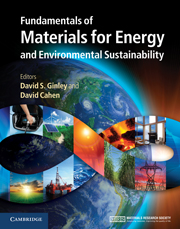Book contents
- Frontmatter
- Contents
- Contributors
- Preface
- Acknowledgments
- Part 1 Energy and the environment: the global landscape
- Part 2 Nonrenewable energy sources
- Part 3 Renewable energy sources
- Part 4 Transportation
- Part 5 Energy efficiency
- Part 6 Energy storage, high-penetration renewables, and grid stabilization
- 42 Toward the smart grid: the US as a case study
- 43 Consequences of high-penetration renewables
- 44 Electrochemical energy storage: batteries and capacitors
- 45 Mechanical energy storage: pumped hydro, CAES, flywheels
- 46 Fuel cells
- 47 Solar fuels
- 48 Solar thermal routes to fuel
- 49 Photoelectrochemistry and hybrid solar conversion
- Summary
- Appendix A Thermodynamics
- Appendix B Electrochemistry
- Appendix C Units
- Index
- References
43 - Consequences of high-penetration renewables
from Part 6 - Energy storage, high-penetration renewables, and grid stabilization
Published online by Cambridge University Press: 05 June 2012
- Frontmatter
- Contents
- Contributors
- Preface
- Acknowledgments
- Part 1 Energy and the environment: the global landscape
- Part 2 Nonrenewable energy sources
- Part 3 Renewable energy sources
- Part 4 Transportation
- Part 5 Energy efficiency
- Part 6 Energy storage, high-penetration renewables, and grid stabilization
- 42 Toward the smart grid: the US as a case study
- 43 Consequences of high-penetration renewables
- 44 Electrochemical energy storage: batteries and capacitors
- 45 Mechanical energy storage: pumped hydro, CAES, flywheels
- 46 Fuel cells
- 47 Solar fuels
- 48 Solar thermal routes to fuel
- 49 Photoelectrochemistry and hybrid solar conversion
- Summary
- Appendix A Thermodynamics
- Appendix B Electrochemistry
- Appendix C Units
- Index
- References
Summary
Focus
The use of wind and solar electricity generation has grown tremendously during the last decade. This raises the important question of how these variable and uncertain resources can be effectively used while maintaining reliable electricity generation.
Synopsis
The large-scale deployment of wind and solar energy creates challenges for grid operators to maintain reliable service. Wind and solar output are variable, uncertain, and often not correlated with normal demand patterns for electricity. At low penetrations in an energy system (up to about 20% on an energy basis) these energy sources act to reduce the fuel use and emissions from conventional power plants used to meet normal variations in electricity demand. These sources can also add varying levels of “firm capacity” to the system, depending on technology and location. Studies have found that current utility systems can accommodate these levels of variable generation sources with a combination of changes in operational practices, but without massive deployment of “enabling” technologies such as energy storage. However, the variability and uncertainty impose modest cost penalties, since utilities require increased operating reserves in order to maintain reliable service. At higher penetrations (beyond 20%) new methods of integrating renewables into the grid are required, including transmitting power over long distances to take advantage of spatial diversity and new generation technologies that can ramp rapidly to respond to variations in demand. At these penetrations variable generation sources also begin to affect the operation of baseload power plants, which creates more challenges for system operators, and may lead to curtailed wind and solar generation. This will begin to decrease the environmental benefits of these renewable sources. At very high penetrations (beyond 30%) the simple coincidence of energy supply and demand limits the useful contributions of wind and solar energy, with wind potentially exceeding the demand for electricity on occasions. This will require deployment of a variety of enabling technologies, including greater use of long-distance transmission, shiftable load, new demands for electricity, such as electric vehicles, and energy storage.
- Type
- Chapter
- Information
- Publisher: Cambridge University PressPrint publication year: 2011
References
- 1
- Cited by



